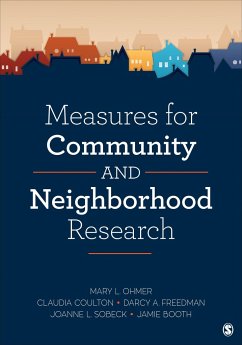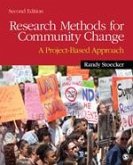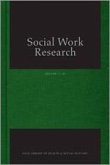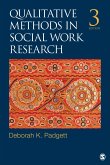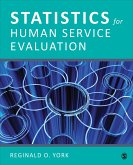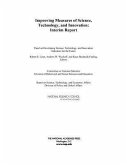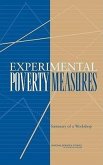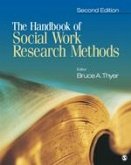Mary L Ohmer, Claudia J Coulton, Freedman, Joanne L Sobeck, Jaime Booth
Measures for Community and Neighborhood Research
Mary L Ohmer, Claudia J Coulton, Freedman, Joanne L Sobeck, Jaime Booth
Measures for Community and Neighborhood Research
- Broschiertes Buch
- Merkliste
- Auf die Merkliste
- Bewerten Bewerten
- Teilen
- Produkt teilen
- Produkterinnerung
- Produkterinnerung
is a reference guide that compiles and organizes key measures for community research, and also compiles the major measures of community practice and assesses them for reliability and validity.
Andere Kunden interessierten sich auch für
![Research Methods for Community Change Research Methods for Community Change]() Randy R StoeckerResearch Methods for Community Change115,99 €
Randy R StoeckerResearch Methods for Community Change115,99 €![Social Work Research Social Work Research]() Social Work Research1.370,99 €
Social Work Research1.370,99 €![Qualitative Methods in Social Work Research Qualitative Methods in Social Work Research]() Deborah K PadgettQualitative Methods in Social Work Research199,99 €
Deborah K PadgettQualitative Methods in Social Work Research199,99 €![Statistics for Human Service Evaluation Statistics for Human Service Evaluation]() Reginald O YorkStatistics for Human Service Evaluation156,99 €
Reginald O YorkStatistics for Human Service Evaluation156,99 €![Improving Measures of Science, Technology, and Innovation Improving Measures of Science, Technology, and Innovation]() National Research CouncilImproving Measures of Science, Technology, and Innovation36,99 €
National Research CouncilImproving Measures of Science, Technology, and Innovation36,99 €![Experimental Poverty Measures Experimental Poverty Measures]() National Research CouncilExperimental Poverty Measures33,99 €
National Research CouncilExperimental Poverty Measures33,99 €![The Handbook of Social Work Research Methods The Handbook of Social Work Research Methods]() Bruce A ThyerThe Handbook of Social Work Research Methods213,99 €
Bruce A ThyerThe Handbook of Social Work Research Methods213,99 €-
-
-
is a reference guide that compiles and organizes key measures for community research, and also compiles the major measures of community practice and assesses them for reliability and validity.
Hinweis: Dieser Artikel kann nur an eine deutsche Lieferadresse ausgeliefert werden.
Hinweis: Dieser Artikel kann nur an eine deutsche Lieferadresse ausgeliefert werden.
Produktdetails
- Produktdetails
- Verlag: Sage Publications
- Seitenzahl: 488
- Erscheinungstermin: 22. August 2018
- Englisch
- Abmessung: 251mm x 173mm x 23mm
- Gewicht: 839g
- ISBN-13: 9781483358369
- ISBN-10: 1483358364
- Artikelnr.: 50562275
- Herstellerkennzeichnung
- Libri GmbH
- Europaallee 1
- 36244 Bad Hersfeld
- gpsr@libri.de
- Verlag: Sage Publications
- Seitenzahl: 488
- Erscheinungstermin: 22. August 2018
- Englisch
- Abmessung: 251mm x 173mm x 23mm
- Gewicht: 839g
- ISBN-13: 9781483358369
- ISBN-10: 1483358364
- Artikelnr.: 50562275
- Herstellerkennzeichnung
- Libri GmbH
- Europaallee 1
- 36244 Bad Hersfeld
- gpsr@libri.de
Mary Ohmer has over twenty years of experience working in community organizing and development around the country with national and local nonprofit and community based organizations, foundations, and government. Dr. Ohmer has taught consensus organizing approaches as part of macro practice and community organizing social work courses. She received her Ph.D. in social work from the University of Pittsburgh in August 2004, and she is currently an assistant professor at the School of Social Work at Georgia State University. Dr. Ohmer is also currently working with the United Way of Metropolitan Atlanta to help them develop and implement an evaluation of the community training.
List of Measures and Tables
Preface
Acknowledgments
INTRODUCTORY CHAPTERS
Chapter 1: Introduction and Purpose
Defining Communities and Neighborhoods
Overview of Measurement Methods and Inclusion Criteria for Measures in this
Book
Measurement Reliability
Measurement Validity
Purpose and Structure
Description of Book Chapters
Conclusion
Chapter 2: Framework for Community and Neighborhood Measurement
Our Conceptual Framework
Conceptual Domains
Examples of Community Measures in Research and Practice
Example Application 1: Improving Access to Healthy Food
Example Application 2: Promotion of Community Health
Example Application 3: Promoting Community Safety and Preventing Violence
Example Application 4: Prevention of Substance Use Disorders
Conclusion
Chapter 3: Methodological Considerations for Community and Neighborhood
Measurement
Methodological Issues When Using Community or Neighborhood-Level Measures
Special Problems With Ecological and Geographic Units
Ecological Fallacy
The Modifiable Areal Unit Problem (MAUP)
Uncertain Geographic Context Problem (UGCoP)
Violation of the Independence Assumption
Sampling Considerations When Community Is the Unit of Analysis
Addressing Sparseness Within Neighborhood Samples
Sampling Neighborhoods or Place-Based Communities
Sample Power in Multi-Level Studies
Assessing the Reliability of Neighborhood-Level Measures: Ecometrics
Overall Methodological Issues for Community and Neighborhood Measurement
Specifying Neighborhood as a Social and Geographic Unit
Administrative Boundaries
Resident-Perceived Neighborhoods
Physical and Spatial Characteristics
Activity Spaces
Considerations in Selecting the Unit of Analysis
Objective Versus Subjective Neighborhood Measurement
Engaging Community Partners in the Selection of Measures
Using New Technology to Measure Neighborhoods
Conclusion
CHAPTERS ON MEASUREMENT INSTRUMENTS
Chapter 4: Community Readiness and Capacity for Change
Defining Community Readiness and Capacity
Community Readiness Model
Community Capacity for Change
Measuring Community Readiness and Capacity
Measures of Community Readiness
Measures of Community Capacity
Combined Measures of Community Readiness and Capacity
Conclusion
Chapter 5: Strategic Collective Action in Communities
The Importance of Measuring Strategic Collective Action
Methods for Measuring Strategic Collective Action
Measures of Strategic Collective Action
Participation, Representation, and Activities
Power
Collaboration
Coalitions
Conclusion
Chapter 6: Social Connections and Processes in Communities
Why is it important to measure social connections and processes in
communities?
Sense of Community (SOC) Measures
Construct Validity of the SOC
SOC as an Individual- and Community-Level Construct
Measures of Neighborhood Social Processes
Collective Efficacy
Neighborhood Matters Measure
Social Capital Measures
Saguaro Seminar on Civic Engagement
Social Capital Measure From the Project on Human Development in Chicago
Neighborhoods
More Recent Social Capital Measures
Conclusion
Chapter 7: Community Empowerment and Engagement
Why is it important to measure community empowerment and engagement?
Empowerment in Communities
Psychological Empowerment Measures
Community Empowerment Measure
Sociopolitical Control Measures
Community and Citizen Participation
Defining Community and Citizen Participation
Measures of Community and Citizen Participation
Civic Engagement
Defining Civic Engagement
Civic Engagement Measures
Conclusion
Chapter 8: Community Resources and Resident Satisfaction
Defining Community Resources and Satisfaction
Community Resources
Community Satisfaction
Satisfaction With Public Services
The Relationship Between Community Satisfaction and Satisfaction With
Public Services
Why Measure Community Resources and Satisfaction?
Methods Used to Measure Community Resources and Satisfaction
Measures of Community Resources
Observation-Based Measures of Resources
Survey-Based Measures of Resources
Combining Observations and Survey Methods to Measure Community Resources
Measures of Community Satisfaction
Measures of Satisfaction With Public Services
Conclusion
Chapter 9: The Built Environment Influencing Healthy Living
Why is it important to measure the built environment?
How is the built environment measured?
Overview of Measures
Neighborhood Food Environment
Walkability of Neighborhoods
Recreation in Neighborhoods
Conclusion
Chapter 10: Housing and Neighborhood Change
Why are measures related to housing and neighborhood change important?
Housing Measures
Measures of Housing Quality
Measures of Housing Affordability
Measures of Housing Market Strength
Neighborhood Change Measures
Measures of Vacancy, Abandonment, and Blight
Measures of Residential Mobility and Housing Unit Turnover
Measures of Gentrification and Displacement
Conclusion
Chapter 11: Community Disorder, Crime, and Violence
Why Is It Important to Measure Disorder, Crime and Violence?
Community Disorder and Order Measures
Defining Community Disorder and Order
Measures of Community Disorder and Order
Fear of Crime
Defining Fear of Crime
Measures of Fear of Crime
Exposure to Community Violence
Defining Exposure to Community Violence
Measures of Exposure to Community Violence Among Children and Adolescents
Measures of Exposure to Community Violence Among Adults
Crime, Violence, and Related Data
Conclusion
Chapter 12: Place-based Social Exclusion and Inequity
Measuring Community Social Disadvantage
Quantifying Place-Based Segregation by Race, Ethnicity, and Income
Minority-Majority Group Measures of Segregation
Multiple Group Segregation Measures
Economic Segregation Measures
Spatial Segregation Measures
Community Diversity Measures
Measurement of Neighborhood Racial and Ethnic Diversity
Measuring Income Diversity in Neighborhoods
Measuring Access to Opportunity
Measures of Job Access
Measures of Access to Services and Amenities
Conclusion
Chapter 13: Community Well-Being and Quality of Life
Defining Well-Being/Quality of Life
Individual Well-Being
Social Well-Being
Community or Neighborhood Well-Being
Why Measure Neighborhood Well-Being/Quality of Life?
As an Alternative to GDP
As an Alternative to DAYL
Well-Being Measures
Facet-Based Measures of Individual Well-Being That Include
Community/Neighborhood Components
Global Measures of Community/Neighborhood Well-Being
Facet-Based Indicators of Community/Neighborhood Well-Being
Measures Used in Surveys
Measures That Use Administrative Data
Measures That Combine Survey Items and Administrative Data
Conclusion
Preface
Acknowledgments
INTRODUCTORY CHAPTERS
Chapter 1: Introduction and Purpose
Defining Communities and Neighborhoods
Overview of Measurement Methods and Inclusion Criteria for Measures in this
Book
Measurement Reliability
Measurement Validity
Purpose and Structure
Description of Book Chapters
Conclusion
Chapter 2: Framework for Community and Neighborhood Measurement
Our Conceptual Framework
Conceptual Domains
Examples of Community Measures in Research and Practice
Example Application 1: Improving Access to Healthy Food
Example Application 2: Promotion of Community Health
Example Application 3: Promoting Community Safety and Preventing Violence
Example Application 4: Prevention of Substance Use Disorders
Conclusion
Chapter 3: Methodological Considerations for Community and Neighborhood
Measurement
Methodological Issues When Using Community or Neighborhood-Level Measures
Special Problems With Ecological and Geographic Units
Ecological Fallacy
The Modifiable Areal Unit Problem (MAUP)
Uncertain Geographic Context Problem (UGCoP)
Violation of the Independence Assumption
Sampling Considerations When Community Is the Unit of Analysis
Addressing Sparseness Within Neighborhood Samples
Sampling Neighborhoods or Place-Based Communities
Sample Power in Multi-Level Studies
Assessing the Reliability of Neighborhood-Level Measures: Ecometrics
Overall Methodological Issues for Community and Neighborhood Measurement
Specifying Neighborhood as a Social and Geographic Unit
Administrative Boundaries
Resident-Perceived Neighborhoods
Physical and Spatial Characteristics
Activity Spaces
Considerations in Selecting the Unit of Analysis
Objective Versus Subjective Neighborhood Measurement
Engaging Community Partners in the Selection of Measures
Using New Technology to Measure Neighborhoods
Conclusion
CHAPTERS ON MEASUREMENT INSTRUMENTS
Chapter 4: Community Readiness and Capacity for Change
Defining Community Readiness and Capacity
Community Readiness Model
Community Capacity for Change
Measuring Community Readiness and Capacity
Measures of Community Readiness
Measures of Community Capacity
Combined Measures of Community Readiness and Capacity
Conclusion
Chapter 5: Strategic Collective Action in Communities
The Importance of Measuring Strategic Collective Action
Methods for Measuring Strategic Collective Action
Measures of Strategic Collective Action
Participation, Representation, and Activities
Power
Collaboration
Coalitions
Conclusion
Chapter 6: Social Connections and Processes in Communities
Why is it important to measure social connections and processes in
communities?
Sense of Community (SOC) Measures
Construct Validity of the SOC
SOC as an Individual- and Community-Level Construct
Measures of Neighborhood Social Processes
Collective Efficacy
Neighborhood Matters Measure
Social Capital Measures
Saguaro Seminar on Civic Engagement
Social Capital Measure From the Project on Human Development in Chicago
Neighborhoods
More Recent Social Capital Measures
Conclusion
Chapter 7: Community Empowerment and Engagement
Why is it important to measure community empowerment and engagement?
Empowerment in Communities
Psychological Empowerment Measures
Community Empowerment Measure
Sociopolitical Control Measures
Community and Citizen Participation
Defining Community and Citizen Participation
Measures of Community and Citizen Participation
Civic Engagement
Defining Civic Engagement
Civic Engagement Measures
Conclusion
Chapter 8: Community Resources and Resident Satisfaction
Defining Community Resources and Satisfaction
Community Resources
Community Satisfaction
Satisfaction With Public Services
The Relationship Between Community Satisfaction and Satisfaction With
Public Services
Why Measure Community Resources and Satisfaction?
Methods Used to Measure Community Resources and Satisfaction
Measures of Community Resources
Observation-Based Measures of Resources
Survey-Based Measures of Resources
Combining Observations and Survey Methods to Measure Community Resources
Measures of Community Satisfaction
Measures of Satisfaction With Public Services
Conclusion
Chapter 9: The Built Environment Influencing Healthy Living
Why is it important to measure the built environment?
How is the built environment measured?
Overview of Measures
Neighborhood Food Environment
Walkability of Neighborhoods
Recreation in Neighborhoods
Conclusion
Chapter 10: Housing and Neighborhood Change
Why are measures related to housing and neighborhood change important?
Housing Measures
Measures of Housing Quality
Measures of Housing Affordability
Measures of Housing Market Strength
Neighborhood Change Measures
Measures of Vacancy, Abandonment, and Blight
Measures of Residential Mobility and Housing Unit Turnover
Measures of Gentrification and Displacement
Conclusion
Chapter 11: Community Disorder, Crime, and Violence
Why Is It Important to Measure Disorder, Crime and Violence?
Community Disorder and Order Measures
Defining Community Disorder and Order
Measures of Community Disorder and Order
Fear of Crime
Defining Fear of Crime
Measures of Fear of Crime
Exposure to Community Violence
Defining Exposure to Community Violence
Measures of Exposure to Community Violence Among Children and Adolescents
Measures of Exposure to Community Violence Among Adults
Crime, Violence, and Related Data
Conclusion
Chapter 12: Place-based Social Exclusion and Inequity
Measuring Community Social Disadvantage
Quantifying Place-Based Segregation by Race, Ethnicity, and Income
Minority-Majority Group Measures of Segregation
Multiple Group Segregation Measures
Economic Segregation Measures
Spatial Segregation Measures
Community Diversity Measures
Measurement of Neighborhood Racial and Ethnic Diversity
Measuring Income Diversity in Neighborhoods
Measuring Access to Opportunity
Measures of Job Access
Measures of Access to Services and Amenities
Conclusion
Chapter 13: Community Well-Being and Quality of Life
Defining Well-Being/Quality of Life
Individual Well-Being
Social Well-Being
Community or Neighborhood Well-Being
Why Measure Neighborhood Well-Being/Quality of Life?
As an Alternative to GDP
As an Alternative to DAYL
Well-Being Measures
Facet-Based Measures of Individual Well-Being That Include
Community/Neighborhood Components
Global Measures of Community/Neighborhood Well-Being
Facet-Based Indicators of Community/Neighborhood Well-Being
Measures Used in Surveys
Measures That Use Administrative Data
Measures That Combine Survey Items and Administrative Data
Conclusion
List of Measures and Tables
Preface
Acknowledgments
INTRODUCTORY CHAPTERS
Chapter 1: Introduction and Purpose
Defining Communities and Neighborhoods
Overview of Measurement Methods and Inclusion Criteria for Measures in this
Book
Measurement Reliability
Measurement Validity
Purpose and Structure
Description of Book Chapters
Conclusion
Chapter 2: Framework for Community and Neighborhood Measurement
Our Conceptual Framework
Conceptual Domains
Examples of Community Measures in Research and Practice
Example Application 1: Improving Access to Healthy Food
Example Application 2: Promotion of Community Health
Example Application 3: Promoting Community Safety and Preventing Violence
Example Application 4: Prevention of Substance Use Disorders
Conclusion
Chapter 3: Methodological Considerations for Community and Neighborhood
Measurement
Methodological Issues When Using Community or Neighborhood-Level Measures
Special Problems With Ecological and Geographic Units
Ecological Fallacy
The Modifiable Areal Unit Problem (MAUP)
Uncertain Geographic Context Problem (UGCoP)
Violation of the Independence Assumption
Sampling Considerations When Community Is the Unit of Analysis
Addressing Sparseness Within Neighborhood Samples
Sampling Neighborhoods or Place-Based Communities
Sample Power in Multi-Level Studies
Assessing the Reliability of Neighborhood-Level Measures: Ecometrics
Overall Methodological Issues for Community and Neighborhood Measurement
Specifying Neighborhood as a Social and Geographic Unit
Administrative Boundaries
Resident-Perceived Neighborhoods
Physical and Spatial Characteristics
Activity Spaces
Considerations in Selecting the Unit of Analysis
Objective Versus Subjective Neighborhood Measurement
Engaging Community Partners in the Selection of Measures
Using New Technology to Measure Neighborhoods
Conclusion
CHAPTERS ON MEASUREMENT INSTRUMENTS
Chapter 4: Community Readiness and Capacity for Change
Defining Community Readiness and Capacity
Community Readiness Model
Community Capacity for Change
Measuring Community Readiness and Capacity
Measures of Community Readiness
Measures of Community Capacity
Combined Measures of Community Readiness and Capacity
Conclusion
Chapter 5: Strategic Collective Action in Communities
The Importance of Measuring Strategic Collective Action
Methods for Measuring Strategic Collective Action
Measures of Strategic Collective Action
Participation, Representation, and Activities
Power
Collaboration
Coalitions
Conclusion
Chapter 6: Social Connections and Processes in Communities
Why is it important to measure social connections and processes in
communities?
Sense of Community (SOC) Measures
Construct Validity of the SOC
SOC as an Individual- and Community-Level Construct
Measures of Neighborhood Social Processes
Collective Efficacy
Neighborhood Matters Measure
Social Capital Measures
Saguaro Seminar on Civic Engagement
Social Capital Measure From the Project on Human Development in Chicago
Neighborhoods
More Recent Social Capital Measures
Conclusion
Chapter 7: Community Empowerment and Engagement
Why is it important to measure community empowerment and engagement?
Empowerment in Communities
Psychological Empowerment Measures
Community Empowerment Measure
Sociopolitical Control Measures
Community and Citizen Participation
Defining Community and Citizen Participation
Measures of Community and Citizen Participation
Civic Engagement
Defining Civic Engagement
Civic Engagement Measures
Conclusion
Chapter 8: Community Resources and Resident Satisfaction
Defining Community Resources and Satisfaction
Community Resources
Community Satisfaction
Satisfaction With Public Services
The Relationship Between Community Satisfaction and Satisfaction With
Public Services
Why Measure Community Resources and Satisfaction?
Methods Used to Measure Community Resources and Satisfaction
Measures of Community Resources
Observation-Based Measures of Resources
Survey-Based Measures of Resources
Combining Observations and Survey Methods to Measure Community Resources
Measures of Community Satisfaction
Measures of Satisfaction With Public Services
Conclusion
Chapter 9: The Built Environment Influencing Healthy Living
Why is it important to measure the built environment?
How is the built environment measured?
Overview of Measures
Neighborhood Food Environment
Walkability of Neighborhoods
Recreation in Neighborhoods
Conclusion
Chapter 10: Housing and Neighborhood Change
Why are measures related to housing and neighborhood change important?
Housing Measures
Measures of Housing Quality
Measures of Housing Affordability
Measures of Housing Market Strength
Neighborhood Change Measures
Measures of Vacancy, Abandonment, and Blight
Measures of Residential Mobility and Housing Unit Turnover
Measures of Gentrification and Displacement
Conclusion
Chapter 11: Community Disorder, Crime, and Violence
Why Is It Important to Measure Disorder, Crime and Violence?
Community Disorder and Order Measures
Defining Community Disorder and Order
Measures of Community Disorder and Order
Fear of Crime
Defining Fear of Crime
Measures of Fear of Crime
Exposure to Community Violence
Defining Exposure to Community Violence
Measures of Exposure to Community Violence Among Children and Adolescents
Measures of Exposure to Community Violence Among Adults
Crime, Violence, and Related Data
Conclusion
Chapter 12: Place-based Social Exclusion and Inequity
Measuring Community Social Disadvantage
Quantifying Place-Based Segregation by Race, Ethnicity, and Income
Minority-Majority Group Measures of Segregation
Multiple Group Segregation Measures
Economic Segregation Measures
Spatial Segregation Measures
Community Diversity Measures
Measurement of Neighborhood Racial and Ethnic Diversity
Measuring Income Diversity in Neighborhoods
Measuring Access to Opportunity
Measures of Job Access
Measures of Access to Services and Amenities
Conclusion
Chapter 13: Community Well-Being and Quality of Life
Defining Well-Being/Quality of Life
Individual Well-Being
Social Well-Being
Community or Neighborhood Well-Being
Why Measure Neighborhood Well-Being/Quality of Life?
As an Alternative to GDP
As an Alternative to DAYL
Well-Being Measures
Facet-Based Measures of Individual Well-Being That Include
Community/Neighborhood Components
Global Measures of Community/Neighborhood Well-Being
Facet-Based Indicators of Community/Neighborhood Well-Being
Measures Used in Surveys
Measures That Use Administrative Data
Measures That Combine Survey Items and Administrative Data
Conclusion
Preface
Acknowledgments
INTRODUCTORY CHAPTERS
Chapter 1: Introduction and Purpose
Defining Communities and Neighborhoods
Overview of Measurement Methods and Inclusion Criteria for Measures in this
Book
Measurement Reliability
Measurement Validity
Purpose and Structure
Description of Book Chapters
Conclusion
Chapter 2: Framework for Community and Neighborhood Measurement
Our Conceptual Framework
Conceptual Domains
Examples of Community Measures in Research and Practice
Example Application 1: Improving Access to Healthy Food
Example Application 2: Promotion of Community Health
Example Application 3: Promoting Community Safety and Preventing Violence
Example Application 4: Prevention of Substance Use Disorders
Conclusion
Chapter 3: Methodological Considerations for Community and Neighborhood
Measurement
Methodological Issues When Using Community or Neighborhood-Level Measures
Special Problems With Ecological and Geographic Units
Ecological Fallacy
The Modifiable Areal Unit Problem (MAUP)
Uncertain Geographic Context Problem (UGCoP)
Violation of the Independence Assumption
Sampling Considerations When Community Is the Unit of Analysis
Addressing Sparseness Within Neighborhood Samples
Sampling Neighborhoods or Place-Based Communities
Sample Power in Multi-Level Studies
Assessing the Reliability of Neighborhood-Level Measures: Ecometrics
Overall Methodological Issues for Community and Neighborhood Measurement
Specifying Neighborhood as a Social and Geographic Unit
Administrative Boundaries
Resident-Perceived Neighborhoods
Physical and Spatial Characteristics
Activity Spaces
Considerations in Selecting the Unit of Analysis
Objective Versus Subjective Neighborhood Measurement
Engaging Community Partners in the Selection of Measures
Using New Technology to Measure Neighborhoods
Conclusion
CHAPTERS ON MEASUREMENT INSTRUMENTS
Chapter 4: Community Readiness and Capacity for Change
Defining Community Readiness and Capacity
Community Readiness Model
Community Capacity for Change
Measuring Community Readiness and Capacity
Measures of Community Readiness
Measures of Community Capacity
Combined Measures of Community Readiness and Capacity
Conclusion
Chapter 5: Strategic Collective Action in Communities
The Importance of Measuring Strategic Collective Action
Methods for Measuring Strategic Collective Action
Measures of Strategic Collective Action
Participation, Representation, and Activities
Power
Collaboration
Coalitions
Conclusion
Chapter 6: Social Connections and Processes in Communities
Why is it important to measure social connections and processes in
communities?
Sense of Community (SOC) Measures
Construct Validity of the SOC
SOC as an Individual- and Community-Level Construct
Measures of Neighborhood Social Processes
Collective Efficacy
Neighborhood Matters Measure
Social Capital Measures
Saguaro Seminar on Civic Engagement
Social Capital Measure From the Project on Human Development in Chicago
Neighborhoods
More Recent Social Capital Measures
Conclusion
Chapter 7: Community Empowerment and Engagement
Why is it important to measure community empowerment and engagement?
Empowerment in Communities
Psychological Empowerment Measures
Community Empowerment Measure
Sociopolitical Control Measures
Community and Citizen Participation
Defining Community and Citizen Participation
Measures of Community and Citizen Participation
Civic Engagement
Defining Civic Engagement
Civic Engagement Measures
Conclusion
Chapter 8: Community Resources and Resident Satisfaction
Defining Community Resources and Satisfaction
Community Resources
Community Satisfaction
Satisfaction With Public Services
The Relationship Between Community Satisfaction and Satisfaction With
Public Services
Why Measure Community Resources and Satisfaction?
Methods Used to Measure Community Resources and Satisfaction
Measures of Community Resources
Observation-Based Measures of Resources
Survey-Based Measures of Resources
Combining Observations and Survey Methods to Measure Community Resources
Measures of Community Satisfaction
Measures of Satisfaction With Public Services
Conclusion
Chapter 9: The Built Environment Influencing Healthy Living
Why is it important to measure the built environment?
How is the built environment measured?
Overview of Measures
Neighborhood Food Environment
Walkability of Neighborhoods
Recreation in Neighborhoods
Conclusion
Chapter 10: Housing and Neighborhood Change
Why are measures related to housing and neighborhood change important?
Housing Measures
Measures of Housing Quality
Measures of Housing Affordability
Measures of Housing Market Strength
Neighborhood Change Measures
Measures of Vacancy, Abandonment, and Blight
Measures of Residential Mobility and Housing Unit Turnover
Measures of Gentrification and Displacement
Conclusion
Chapter 11: Community Disorder, Crime, and Violence
Why Is It Important to Measure Disorder, Crime and Violence?
Community Disorder and Order Measures
Defining Community Disorder and Order
Measures of Community Disorder and Order
Fear of Crime
Defining Fear of Crime
Measures of Fear of Crime
Exposure to Community Violence
Defining Exposure to Community Violence
Measures of Exposure to Community Violence Among Children and Adolescents
Measures of Exposure to Community Violence Among Adults
Crime, Violence, and Related Data
Conclusion
Chapter 12: Place-based Social Exclusion and Inequity
Measuring Community Social Disadvantage
Quantifying Place-Based Segregation by Race, Ethnicity, and Income
Minority-Majority Group Measures of Segregation
Multiple Group Segregation Measures
Economic Segregation Measures
Spatial Segregation Measures
Community Diversity Measures
Measurement of Neighborhood Racial and Ethnic Diversity
Measuring Income Diversity in Neighborhoods
Measuring Access to Opportunity
Measures of Job Access
Measures of Access to Services and Amenities
Conclusion
Chapter 13: Community Well-Being and Quality of Life
Defining Well-Being/Quality of Life
Individual Well-Being
Social Well-Being
Community or Neighborhood Well-Being
Why Measure Neighborhood Well-Being/Quality of Life?
As an Alternative to GDP
As an Alternative to DAYL
Well-Being Measures
Facet-Based Measures of Individual Well-Being That Include
Community/Neighborhood Components
Global Measures of Community/Neighborhood Well-Being
Facet-Based Indicators of Community/Neighborhood Well-Being
Measures Used in Surveys
Measures That Use Administrative Data
Measures That Combine Survey Items and Administrative Data
Conclusion

